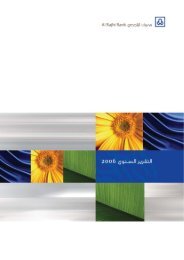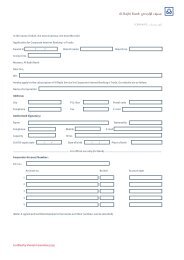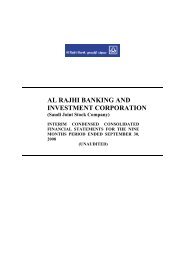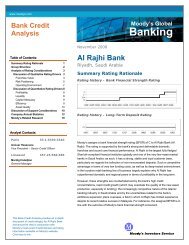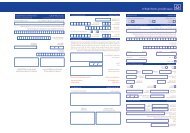Global Credit Research - Al Rajhi Bank
Global Credit Research - Al Rajhi Bank
Global Credit Research - Al Rajhi Bank
You also want an ePaper? Increase the reach of your titles
YUMPU automatically turns print PDFs into web optimized ePapers that Google loves.
to bring some geographic diversification to the bank's business model and revenues. However, the success of<br />
such a venture will ultimately depend on the bank's ability to capture a material portion of the Malaysian retail<br />
market, while deploying sufficiently conservative and sound risk management systems in a market far more<br />
competitive than that of Saudi Arabia. We understand that <strong>Al</strong> <strong>Rajhi</strong> has more ambitious plans for overseas<br />
expansion, which are currently being reviewed by management and the Board: while <strong>Al</strong> <strong>Rajhi</strong> is expected to retain<br />
full control over the international outlets to be deployed in other Muslim countries, the bank has a limited track<br />
record of running a wider spectrum of foreign operations, and therefore might face risk categories it is not used to<br />
managing.<br />
The scorecard outcome of B- for franchise value reflects <strong>Al</strong> <strong>Rajhi</strong>'s well-established market position in Saudi Arabia<br />
as the largest Islamic bank in the region, commanding a 13% market share of banking assets, as well as its<br />
strengths in retail banking and efforts to diversify its business model, from both a geographic and an operating<br />
perspective.<br />
Factor 2: Risk Positioning<br />
Trend: Neutral<br />
<strong>Al</strong> <strong>Rajhi</strong>'s risk positioning is weakened by high concentration risks, which is also the case for the bank's domestic<br />
and regional peers. This is especially the case in terms of credit exposures, and more precisely in the corporate<br />
banking book -- an issue faced by the vast majority of Saudi banks; however, the bank's retail portfolio is relatively<br />
granular. As the domestic economy is dominated by a relatively small number of large corporate groups,<br />
concentration by name and sector is a constraint for the banking system as a whole, and is expected to remain so<br />
in the medium term. Having said that, large exposures are of good credit quality and usually well collateralized. In<br />
addition, despite a nascent international expansion, <strong>Al</strong> <strong>Rajhi</strong> remains a domestic player, very much dependent on<br />
the Kingdom's economic cycle. On the other side of the balance sheet, concentration risks are more limited, as the<br />
dominant share of funding sources is extracted from the retail market, diversified by definition.<br />
Unlike some of its domestic and regional peers, <strong>Al</strong> <strong>Rajhi</strong> does not rely on a limited number of wholesale customers.<br />
Finally, the shareholding structure is also concentrated, in light of the <strong>Al</strong> <strong>Rajhi</strong> family's controlling stake in the bank,<br />
which is not the most ideal environment for an optimal corporate governance architecture to emerge. However,<br />
under the auspices of SAMA, the bank's majority shareholders and its proactive senior management team, <strong>Al</strong> <strong>Rajhi</strong><br />
has considerably strengthened its compliance function, corporate governance infrastructure and risk management<br />
framework over the past 12 months.<br />
<strong>Al</strong> <strong>Rajhi</strong>'s enterprise risk management is now solid and compares favourably with that of peers. The risk<br />
management function, overseen by experienced specialists, is independent, well-staffed and comprehensibly<br />
covers all relevant standard risk categories across business lines. <strong>Al</strong> <strong>Rajhi</strong>'s risk appetite is relatively low: the bank<br />
engages mainly in plain vanilla intermediation and investment banking, avoiding complex, unfamiliar and exotic<br />
transactions, with the exception of a few corporate finance transactions for the largest Saudi firms. <strong>Al</strong> <strong>Rajhi</strong>'s risk<br />
profile is dominated by credit risk, where it has adopted a much centralised culture in assessing and pricing risk.<br />
Concentration risks are a fact of life in Saudi Arabia, and are expected to be captured through additional capital<br />
charges under <strong>Al</strong> <strong>Rajhi</strong>'s imminent implementation of Basel II's pillar 2 guidelines as interpreted by SAMA. Market<br />
risks are limited and operational risks appear to be sufficiently scrutinised.<br />
The bank's overall score for risk positioning is D.<br />
Factor 3: Regulatory Environment<br />
For a discussion of the regulatory environment, refer to Moody's latest <strong>Bank</strong>ing System Outlook for Saudi Arabia,<br />
published in November 2007.<br />
Factor 4: Operating Environment<br />
Trend: Improving<br />
This factor is also common to all Saudi banks. Moody's assigns a D score for the Kingdom's overall operating<br />
environment, partly reflecting the significant volatility of the country's economic real and nominal output, the still<br />
limited diversification beyond the hydrocarbon sector, current and future challenges with regard to employment and<br />
human capital, as well as some structural weaknesses in terms of the rules of law.<br />
However, we note that this score may not fully capture Saudi Arabia's special status as the global leader in oil<br />
production, facing limited pressure in terms of liquidity and engaged in very ambitious plans for developing its<br />
economic infrastructure within the upstream and downstream oil industry sector but also in view of enhancing<br />
output diversification in mining, power and water, services, transportation and financial services. <strong>Al</strong>ong with the<br />
planned mortgage law, such initiatives are expected to provide the Kingdom's banking industry with sizeable<br />
engines for sustainable growth going forward. Finally, economic stability, as measured by the relative volatility of<br />
macroeconomic indicators, has mostly been in an upwards direction, with means that high GDP cyclicality has



